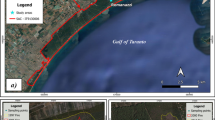Abstract
The aboveground nutrient turnover of three ecosystems representing the main stages of heathland forest succession in NW Germany was investigated in a comparative study with regard to nutrient availability of the soil and light availability below the canopy. It was expected that nutrient availability would play a decisive role in forest development on nutrient poor acidic soil. The results show that the input of nutrients into the Calluna heathland is higher than the annual aboveground turnover of N, P, Ca, Mg, and K via litterfall. Compared to the pioneering birch-pine forest, the annual aboveground turnover of nutrients within the Calluna heathland, and therefore the nutrient availability is very low, while the light availability below the canopy is high. The increasing productivity of the growing successional forest is combined with an increasing nutrient turnover, mainly via litter fall. As a result, the increasing nutrient availability favours shade tolerant species with a higher nutrient demand at the late stages of succession. Consequently, the presumed terminal stage of succession, the oak-beech forest, is characterized by low light availability below the canopy and higher nutrient supply according to the resource-ratio hypothesis of Tilman (1985, 1986, 1988).
Similar content being viewed by others
References
Bazzaz F A 1990 Plant-plant interactions in successional environments. In Perspectives on Plant Competition. Eds. J BGrace and DTilman. pp 239–263. Academic Press, San Diego, CA.
Berendse F 1990 Organic matter accumulation and nitrogen mineralization during secondary succession in heathland ecosystems. J. Ecol. 78, 413–427.
Berendse F, Aerts R and Bobbink R 1993 Atmospheric nitrogen deposition and its impact on terrestrial ecosystems. In Landscape Ecology of a Stressed Environment. Eds. C CVos and POpdam. pp 104–121. Chapman and Hall. London.
Bredemeier M 1987 Stoffbilanzen, interne Protonenproduktion und Gesamtsäurebelastung des Bodens in verschiedenen Waldökosystemen Norddeutschlands. Ber. Forschungszentrum Waldökosysteme Univ. Göttingen, A33, 133 p.
Bredemeier M 1988 Forest canopy transformation of atmospheric deposition. Water Air Soil Pollut. 40, 121–138.
Cole D W and Rapp M 1980 Element cycling in forested ecosystems. In Dynamic Properties of Forest Ecosystems. Ed. D EReichle. pp 314–409. Cambridge Univ. Press, Cambridge.
Gimmingham C H 1981 Conservation: European heathlands. In Ecosystems of the World: Heathlands and Related Shrublands. Ed. R LSpecht. pp 249–259. Elsevier Scientific Publ. Comp., Amsterdam, Oxford, New York.
Griese F 1987 Untersuchungen über die natürliche Wiederbewaldung von Heide-Flächen im niedersächsischen Flachland. Diss. Univ. Göttingen. 163 p.
Horn H S 1974 The ecology of secondary succession. Ann. Rev. Ecol. Syst. 5, 25–37.
Ingestad T 1987 New concepts on soil fertility and plant nutrition as illustrated by research on forest trees and stands. Geoderma 40, 237–252.
Leuschner C 1993 Resource availability at three presumed stages of a heathland succession on the Lüneburger Heide area, Germany. J. Veg. Sci. 4, 255–262.
Leuschner C, Rode M W and Heinken T 1993 Gibt es eine Nährstoffmangel-Grenze im nordwestdeutschen Flachland? Flora 88, 239–249.
Peet R K and Christensen N L 1980 Succession: a population process. Vegetatio 43, 131–140.
Pickett S T A, Collins S L and Armesto J J 1987 A hierarchical consideration of causes and mechanisms of succession. Vegetatio 69, 109–114.
Rode M W 1993 Leaf nutrient accumulation and turnover at three stages of succession from heathland to forest. J. Veg. Sci. 4, 263–268.
Rode M W and Heinken T 1993 Der Einfluß der Vegetation auf die Nährstoffverteilung in stark versauerten, nährstoffarmen Böden der Lüneburger Heide. Scri. Geobotanica 20, 21–38.
Rode M W, Leuschner C, Clauss C, Danner E, Gerdelmann V, Margraf S and Runge M 1993 Changes in nutrient availability and nutrient turnover during heathland forest succession in NW Germany. Scri. Geobotanica 21, 85–96.
Rode M W, Leuschner C, Runge M, Clauss C, Lübbe K and Margraf S 1992 Heathland forest succession in NW-Germany: Morphological and chemical properties of the soil under different successional stages. In Responses of Forest Eco-systems to Environmental Changes. Eds. ATeller, PMathy and J N RJeffers. pp 780–781. Elsevier Applied Science, London, New York.
Tilman D 1985 The resource ratio hypothesis of succession. Am. Nat. 125, 827–852.
Tilman D 1986 Resources, competition and the dynamics of plant communities. In Plant Ecology. Ed. M JCrawley. pp 51–75. Blackwell Scientific Publ., Oxford, London, Boston.
Tilman D 1988 Plant strategies and the dynamics and structure of plant communities. Princeton Univ. Press, Princeton, NJ.
Tilman D 1990 Mechanisms of plant competition for nutrients: The elements of a predictive theory of competition. In Perspectives on Plant Competition. Eds. J BGrace and DTilman. pp 117–141. Academic Press, San Diego, CA.
Ulrich B 1983 Interaction of forest canopies with atmospheric constituents: SO2, alkali and earth alkali cations and chloride. In Effects of accumulation of air pollutants in forest ecosystems. Eds. BUlrich and JPankrath. pp 33–45. D. Reidel Publ. Comp., Dordrecht The Netherlands.
Ulrich B 1987 Stability, elasticity, and resiliance of terrestrial ecosystems with respect to matter balance. Ecol. Stud. 61, 11–49.
Ulrich B 1991 Rechenweg zur Schätzung der Flüsse in Waldökosystemen und Identifizierung der sie bedingenden Prozesse. Ber. Forschungszentrum Waldökosysteme Univ. Göttingen B24, 204–210.
Vitousek P 1982 Nutrient cycling and nutrient use efficiency. Am. Nat. 119, 553–572.
West D C, Shugart H H and Botkin D B (Eds) 1981 Forest Succession: Concepts and Application. Springer-Verlag, Berlin, New York.
Author information
Authors and Affiliations
Rights and permissions
About this article
Cite this article
Rode, M.W. Aboveground nutrient cycling and forest development on poor sandy soil. Plant Soil 168, 337–343 (1995). https://doi.org/10.1007/BF00029346
Issue Date:
DOI: https://doi.org/10.1007/BF00029346




